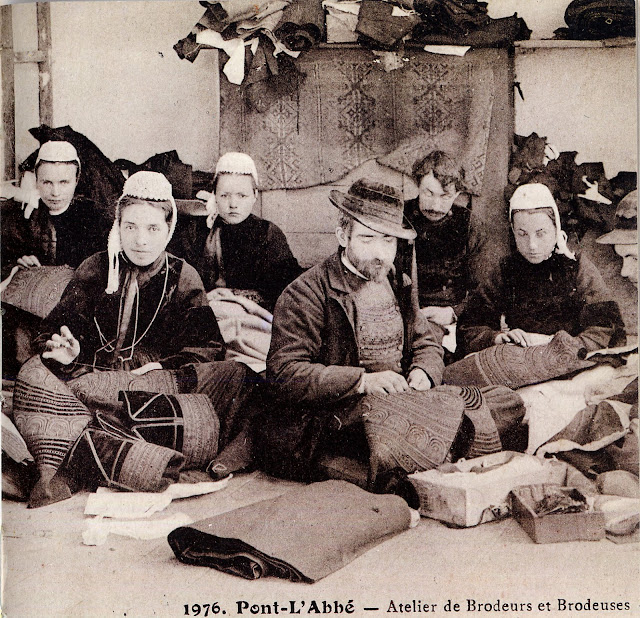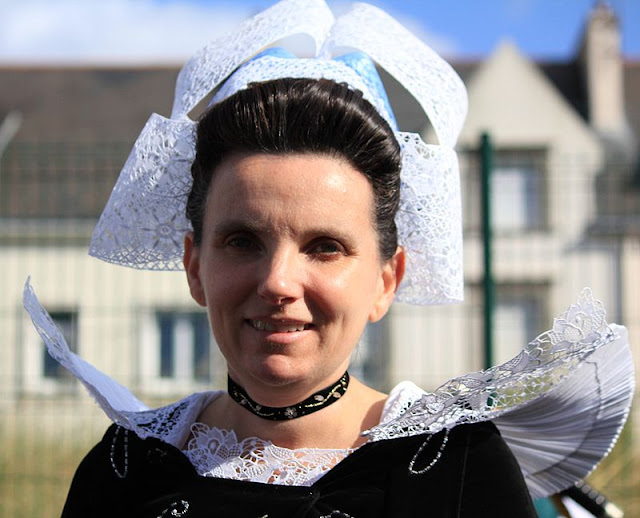Hello all,
Today I will continue my coverage of Gernew or Cornouaille by talking about the southern part of the region. This contains the most famous Breton Costumes, which are still alive today, as well as some less well known. I will again proceed west to east. Note that even this set of articles are a simplification. In fact, the costume and coif varied by age, social class and time period as well as by region.
Bro-Gernev
Cornouaille in French
Enez-Sun
Île de Sein in French
This is an island off the west coast of Brittany. The costume and coif are unique, and are all in black. The women adopted the mourning coif permanently after a disaster in the 1700's. The people of the island make their living from fishing and salvaging wrecks.
Kraozon, Douarnenez, Enez Tudi and Konk-Kerne
Crozon, Douarnenez, Île-Tudy and Concarneau in French
Originally the women of these areas wore a coif similar to that of Plougastell or Kemper, but in the 19th century fish canneries were built which employed many women of the coasts. The costumes and coifs became simplified and smaller so as to be more practical for work. The result is the coif called penn-sardin [sardine-head in Breton]. This term was also commonly used to refer to the women who worked in the canneries. Famously, they took part in some of the earliest demonstrations for workers rights in France.
In Crozon, and Douarnenez, the large embroidered shawl seen in Leon and also the cornette were worn at times for solemn occasions.
Crozon
Douarnenez
Concarneau
Île-Tudy
Ploare, Ploaré in French, which lay just east of Douarnenez, and of which it now forms a quarter, had a very colorful costume which greatly resembled that of Kemper. It had a great deal of colorful embroidery.
Even after the adoption of the penn sardin, the Ploare costume has continued to include impressive embroideries.
Embroidery on man's vest.
Cap Sizun
In this region the coif retained the loop around the back which was lost in the penn sardin.
Pontekroaz
Pont-Croix in French
The literature claims that in Pont Croix they wear the original coif that predates the penn sardin. I have found very little in the way of images.
Keriti Pennmarc'h
Kérity Pennmarch in French
Keriti is a small town on the south coast of the Bigouden region, near Pennmarc'h. While surrounded by the Bigouden costume they have retained their own particular coif and manner of dress.
Here the Kerity costume is on the right.
Here we see both the Kerity and Bigouden coifs at a religious service.
The next three costumes are the most famous in all Brittany. Each is found over a substantial area.
Bro Vigoudenn
Pays Bigouden in French
Often called Pont-l'Abbe after the main city of this region. This is the costume shown in the image at the head of the article. It is remarkable for the amount of embroidery on both the old and new forms of the costume. Both are still seen today. The old costume was remarkable for the many layers worn. It was worn with a short cap shaped coif with colored embroidery on the sides and white embroidery on the cap itself.
In the 20th cent. both the women's and men's vests began to be covered with gold embroidery. The layers were reduced and the garments simplified. The coifs, however, became taller and taller.
Bro Glazik or Kemper
Pays Glazik or Quimper in French
This region is called Glazik country, it is sometimes referred to by the name of its major city, Kemper [Quimper in French]. In the 1800's, the costume was very colorful, especially in the north, between Ploare and Briec. The main color was often red. At that time, Ploare wore the Glazik costume, before they adopted the penn sardin.
In this photo we see the progression of the Kemper costume, from the 18th cent costume on the left, through the 19th cent, when the colors become more somber, often with a predominance of blue, and then the 20th cent, when the costume became black with bead embroidery. The cut of the clothing became simpler and the coif became progressively smaller.
Some images of the second phase.
In the third stage elaborate embroidery also appeared on the men's vests and jackets.
Bro an Aven or Rosporden
Pays de l'Aven or Rosporden in French
Rosporden is the largest city in this region. This is the last costume found in Gernew or Cornouaille. The costume itself is called Giz Fouen. It is also called the costume of Pont Aven or Fouesnante. The costume is found over a rather large area, and the unique coif comes in a dozen variations. It looks a bit like the coif of Chateauneuf du Fao, but with wider lace bands. The costume also includes a goffered collarette, some flat, but some formed into curves.
The original coif resembled that of the surrounding areas before being modified into the confection that exists today.
The collar is a remnant of the Elizabethan era. Here are a couple of photos showing the goffering process.
The men's vests and jackets also developed embroidery, but with a somewhat different composition than in Kemper.
Perhaps later I will do an more in depth look at this costume, but for now here are various images which are not sorted by region or time period. This costume cannot be mistaken for any other.
That concludes this article. Thank you for reading, I hope that you have found this to be interesting and informative. You might even want to try your hand at some of the embroidery included today.
Roman K
email: rkozakand@aol.com
Source material:
Victor Lhuer, 'Les Costumes Bretons', 2001
Pierre Jakez Helias, 'Coiffes et Costumes de Bretagne', Chateaulin, 1983
Josepj Jigourel & Yanna Fournier, 'Costumes de Bretagne', Brest, 2000
Bruno Helias, 'Breton Costumes', Florence, 1997
Yann Guesdon, 'Costumes de Bretagne', Quimper, 2011





























































































































































































































Loved this whole article! Lived in Kemper, but travelled all around Cornouaille. Fascinating to see the differences in real life at festes now or others. 😍😍
ReplyDelete